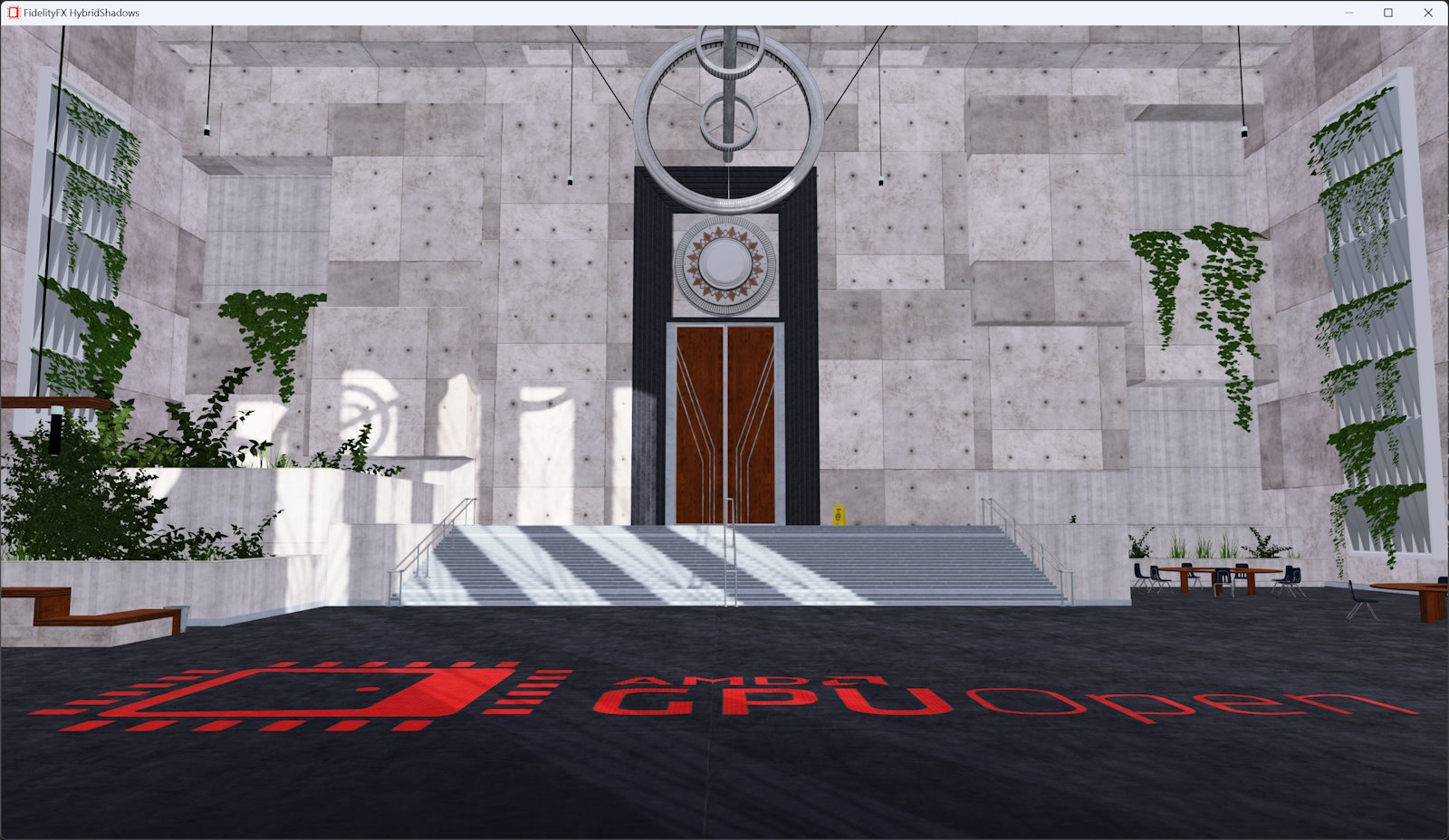FidelityFX Hybrid Shadows

This sample demonstrates the use of the FidelityFX Classifier and FidelityFX Denoiser techniques.
For details on the techniques that underpins the FidelityFX Hybrid Reflections effect you can refer to the respective FidelityFX Classifier documentation and FidelityFX Denoiser documentation.
Slides which review the main steps of FidelityFX Hybrid Shadows sample can be found here.
Requirements
- Windows
- DirectX(R)12
- Vulkan(R)
UI elements
The sample contains various UI elements to help you explore the techniques it demonstrates. The table below summarises the UI elements and what they control within the sample.
Controls
| Element name | Value | Description |
|---|---|---|
| Run Hybrid Shadow | Checked/Unchecked | Enable/Disable the hybrid shadows. |
| Use Denoiser | Checked/Unchecked | Enable/Disable the shadow denoiser. |
| Sun Solid Angle | 0.0 - 1.0 | Controls the size of the sun light. |
| Debug Mode | Disabled, Show RayTraced Tiles, Show Ray minT, Show Ray maxT, Show Ray length, Show RayTracing Texture | Used to select the debug output view. |
| TileCutOff | 0 - 32 | Used to discard a tile where not enough rays need to be traced in the FidelityFX Classifier. |
| PCF Offset | Checked/Unchecked | Used to offset the blocker depth value in the FidelityFX Classifier. |
| Reject Lit Pixels for Ray Tracing | Checked/Unchecked | Used to discard pixels for ray tracing that are in lit areas in the FidelityFX Classifier. |
| Use Shadow Maps to determine RayT | Checked/Unchecked | Enable/Disable the use of shadow maps to determine ray properties. |
Setting up FidelityFX Hybrid Shadows
The FidelityFX Hybrid Shadows sample uses FidelityFX Classifier to generate a list of tiles on the screen from which a ray tracing kernel can be launched. Then, the FidelityFX Denoiser can be enabled to remove noise from the raw, 1 sample per pixel ray tracing output.
Setting up classifier
Include the interface for the backend of the FidelityFX Classifier API.
#include <FidelityFX/host/ffx_classifier.h>Create FidelityFX Classifier context
m_ClassifierCtxDesc.flags = FFX_CLASSIFIER_SHADOW;m_ClassifierCtxDesc.flags |= FFX_CLASSIFIER_CLASSIFY_BY_CASCADES;m_ClassifierCtxDesc.resolution.width = resInfo.RenderWidth;m_ClassifierCtxDesc.resolution.height = resInfo.RenderHeight;m_ClassifierCtxDesc.flags |= GetConfig()->InvertedDepth ? FFX_CLASSIFIER_ENABLE_DEPTH_INVERTED : 0;m_ClassifierCtxDesc.backendInterface = backendInterface;FFX_ASSERT(ffxClassifierContextCreate(&m_ClassifierContext, &m_ClassifierCtxDesc) == FFX_OK);Set up the dispatch parameters and dispatch
FfxClassifierShadowDispatchDescription shadowClassifierDispatchParams = {};shadowClassifierDispatchParams.commandList = ffxGetCommandList(pCmdList);...FFX_ASSERT(FFX_OK == ffxClassifierContextShadowDispatch(&m_ClassifierContext, &shadowClassifierDispatchParams));Setting up the FidelityFX Denoiser
Include the interface for the backend of the FidelityFX Denoiser API.
C++:
#include <FidelityFX/host/ffx_denoiser.h>Create FidelityFX Denoiser context
m_DenoiserCtxDesc.flags = FFX_DENOISER_SHADOWS;m_DenoiserCtxDesc.windowSize.width = resInfo.RenderWidth;m_DenoiserCtxDesc.windowSize.height = resInfo.RenderHeight;m_DenoiserCtxDesc.flags |= GetConfig()->InvertedDepth ? FFX_CLASSIFIER_ENABLE_DEPTH_INVERTED : 0;m_DenoiserCtxDesc.backendInterface = backendInterface;FFX_ASSERT(ffxDenoiserContextCreate(&m_DenoiserContext, &m_DenoiserCtxDesc) == FFX_OK);Set up the dispatch parameters and dispatch
FfxDenoiserShadowsDispatchDescription denoiserDispatchDescription = {};denoiserDispatchDescription.commandList = ffxGetCommandList(pCmdList);...FFX_ASSERT(FFX_OK == ffxDenoiserContextDispatchShadows(&m_DenoiserContext, &denoiserDispatchDescription));Sample controls and configurations
For sample controls, configuration, and FidelityFX Cauldron Framework UI element details, see Running the samples.